Sunday Zazen Session

Participate in Sunday Zazen at Daijoji Temple
Have you ever been tired of the unsurprising and conventional literature of usual tourist guidebooks? Have you ever felt like straying from their recommended tours? Mostly, have you ever experienced this indefinable and fleeting emotion that unexpected encounters of a hidden place or scarce atmospheres often provide? When most people hear the word “zazen,” they think of an esoteric form of mediation that is shrouded in mystery and inaccessible to the layman. I myself did not know much about zazen until recently, and as a result, I was slightly apprehensive at first when I was asked to participate in Sunday Zazen at Daijoji Temple.
By Robert Wertheim / Published: March 30, 2011

The temple in a mountainous
area removed from the hustle
and bustle of the city
Arriving at the Daijoji temple grounds, any concerns I had disappeared. The temple itself is located in a mountainous area removed from the hustle and bustle of the city, and it tranquil atmosphere resembles Wakayama’s Mt. Koya. To enter the temple, you first go through the “so-mon,” which is the primary main gate, after which you pass through the “san-mon,” the secondary main gate. These gates are nicknamed “black gate” and “red gate” due to their respective colors.
After entering both gates and walking a few minutes, you reach the reception for the zazen service. After taking off your shoes, you may enter the reception room. Greet the receptionist by pressing your palms together, fingertips at nose height, and bowing slightly (“gassho”). Write in your name, address, and phone number in the record book, and draw a circle if it is your first time participating. While there is no required fee to participate, donations are amiably accepted, and I noticed most people put in an average of 500 yen. This is the only form of income the monks have, and if you stay for the lecture after the zazen session, tea and sweets are served, so please donate whatever amount you feel is right.
Leave cell phones and
watches there, and also take
any socks or jewelry off.
After registering, you can wait in the waiting room until the zazen session starts around 1:30 p.m.
Next, take your zafu (the cushion in front of you), and plump it up to make it round. Watch the way the monk rotates it, and do the same. Then to sit down, you must get your body onto the raised platform. Keep in mind though, that the wooden exposed part of the platform is where the monks eat, so make sure that your behind or your bare feet do not touch the wood when you prop yourself up.
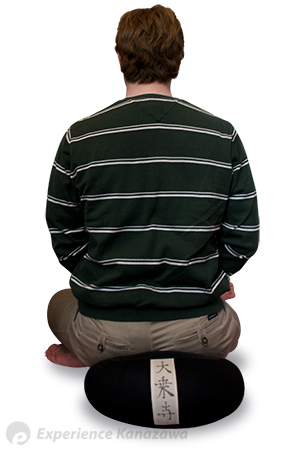
Two positions to choose from:
the full-lotus position
or the half-lotus position
When doing zazen at Daijoji, there are two positions to choose from: the full-lotus position or the half-lotus position. The former is very hard for beginners to do, and almost impossible for most first timers, so I recommend the half-lotus position, in which you place your left foot on your right thigh.Once seated, cup you left hand in your right, with your thumbs touching each other (“hokkaijoin”).
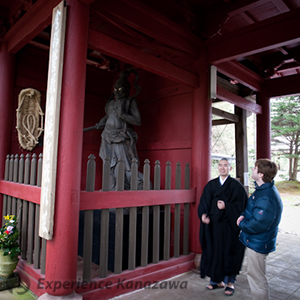
This hand position is nicknamed the “egg position” because the space between your hands and thumbs should resemble an egg. Both of your knees should rest firmly on the square mat (“zabuton”). Your back and spine should be straight, and you should tuck your chin in. Once you get into the right position, you can relax your shoulders and back, but do not lose your posture. Focus on a spot in front of you, and gazedownward at about a 45 degree angle. Youreyes should not be open wide, but do not close them either. Take one big breath out, then one in, and after that breathe normally through your nose.
Three bells will ring, which will indicate that the zazen session is starting. The lights will also dim. After the bells ring, you have 40 minutes to mediate, with the goal of freeing your mind of any thoughts, and being almost not aware of your own existence. Needless to say, even emptying one’s mind is a very challenging goal, and I was quite worried about how I would fare.
Surprisingly though, I became very relaxed quickly, but never felt sleepy. Contrary to my expectations, I was able to free my mind of its worries, and the 40 minutes passed extremely quickly. When two bells ring, it means the first 40 minute session is over, and that it is time to do walking zazen, known as “kinhin.” Before you get up, bow doing gassho, then sway your body back and forth gently. Your legs will probably have gotten very stiff as mine were, so slowly get up after turning around 180 degrees. After you step down to the floor, plump your zafu again, and bow in gassho position one more time.
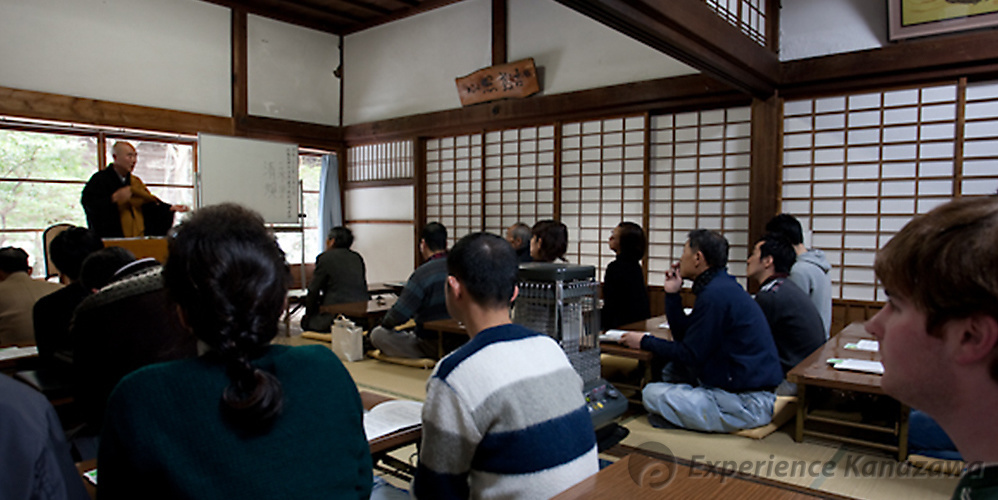
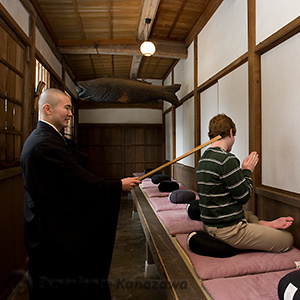
Kinhin helped me get
the blood really circulating
in my legs
While doing kinhin, you will walk around in a circle using small steps. Start with your right foot, and overlap your successive steps. Your hands should be in shashu position. Personally, I felt the kinhin helped me get the blood really circulating in my legs, and was another enjoyable form of mediation. After kinhin, one bell will ring, which signifies that the first session is over. There is a short break where you can relax or go to the bathroom. Afterwards, the second session of zazen begins.
During the second session, I did not have as much success clearing my mind as I did the first time. I got overconfident due to my initial success, and ended up starting to think about the work I had to do the next week. I was recommended not to fight my thoughts, rather, to let them float in and out of my mind, which they did. At one point, however, a song persistently looped through my head and I was losing concentration. At that point, I decided to enlist the help of the monk, in the form of “kyosaku.”
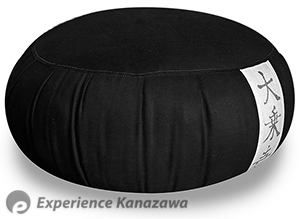
“Kyosaku” may seem scary or like a punishment at first, but it is actually the monk’s way of helping you regain your concentration or get rid of your sleepiness.First put your hands in the gassho position and bow. The monk will make his way over to you and tap your back lightly with a flat wooden stick to let you know his behind you. Then, after you bend your neck to the side, he will swiftly hit your shoulder. When I had a monk demonstrate this on me in a private session, he hit me quite hard and I was surprised, but when I had this done in the actual zazen session, I think the head monk went easy on me. In any case, it is a good way to refresh yourself and regain your concentration if you feel you are getting off track.
Afterwards, you can listen
to the monk give
an hour-long sermon.
After the second 40 minutes of zazen are over, kinhin is performed once more, and then the session is completely over!Afterwards, you can listen to the monk give an hour-long sermon.This is optional though, and if you don’t understand Japanese or don’t have time to attend, you can leave.
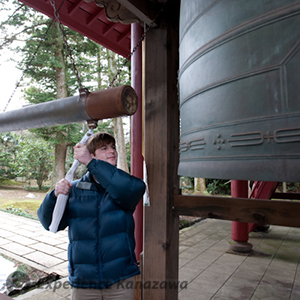
I chose to stay for the monk’s sermon, and was very impressed by it.While the Buddhist texts were hard to understand themselves, the monk who gave the sermon explained everything very clearly, and I even made interesting connections between Buddhism and western religions.
I encourage you to try
it yourself at least once!
In closing, for those of you who have never done zazen, or are thinking about it but are apprehensive, I encourage you to try it yourself at least once! The monks are very accommodating, and do as much as they can to make beginners comfortable. The whole process is a very relaxing experience, and more likely than not, you will want to go back again soon!
Daijoji Temple can be reached by car, taxi, or by taking a number of bus routes to the “Heiwa-machi” bus stop and walking for a several minutes.
Sunday Zazen Session
Place: Daijoji Temple (Ru - 10, Nagasaka-Machi, Kanazawa)
Dates: every sunday / Time: Zazen (13:30~); Sermon and tea time (15:00~)
Admission: Free *This temple is not a touristy place. Please do not forget donating as a common courtesy! They will serve you a cup of tea and a confection during the sermon, we recommend you to leave 500 yen at least as etiquette.
Kanazawa Area
Kenrokuenn Garden
Following Matsuo Bashô’s steps in Ishikawa - 1/6 [Introduction]
Following Matsuo Bashô’s steps in Ishikawa - 2/6 [Kanazawa]
Noto Area
Mitsukejima Island
Kaga Area
Following Matsuo Bashô’s steps in Ishikawa - 3/6 [Komatsu City]
Following Matsuo Bashô’s steps in Ishikawa - 4/6 [Natadera Temple]
Following Matsuo Bashô’s steps in Ishikawa - 5/6 [Yamanaka Onsen Town]
Following Matsuo Bashô’s steps in Ishikawa - 6/6 [Daishoji District]
Rosanjin in Yamashiro Onsen Town
Stroll Kanazawa in Rental Kimono - 1/2 [Kimono Rental]
Stroll Kanazawa in Rental Kimono - 2/2 [Kimono Stroll]
January
Enyukai: Geisha Party
February
Setsubun-Sai Festival
AUGUST
Issaki Hoh-Toh Matsuri
November
Enyukai: Geisha Party
